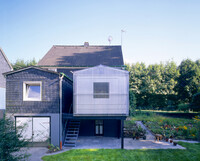
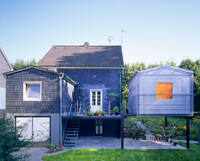
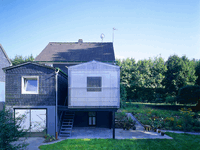
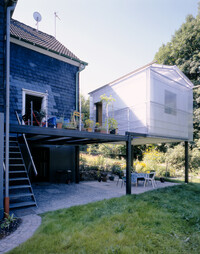
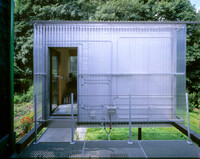
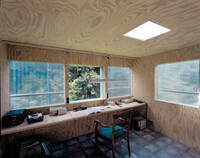
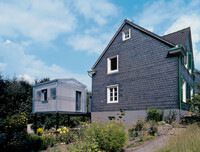
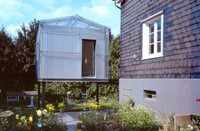
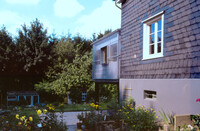
A Trip to the Countryside - Mobile Workspace
The objective set up by the clients – who are journalists – was to create an additional study. The extension of a garage which is integrated within the house was originally envisaged. The typical timber-framed house with a large garden is located in a nature reserve. The clients were inhabiting the ground floor. The intensively used garden was only accessible from the basement via an internal staircase. The tenant in the first floor should not have to move out.
Assumptions. Lack of direct access to the garden. The additional space requirement is only temporary. It will be dispensable since a later shared use of the upper floor is planned.
Process as a concept. Besides the objective to create space for living we wanted to achieve certain aims: Proximity and stronger integration of the house and the garden.
Mimicry. Differentiation of the requirements during the summer and winter periods: The terrace is only used during the summer, The space should have immediate access from the house during the winter, It should be possible to move the extension according to the season.
Metamorphosis. The extension will change its function since the shared use of the first floor is envisaged. After dismounting the low-budget interior it can be easily converted into a greenhouse. The exterior appearance will change as a result.
Context. The proportion of the new part mimics an existing extension added in the 1950s. The distinction is established by the materials: dissimilar twins.
Material. The main supporting structure consists of a steel framework. The terrace is covered with metal gratings in order to let light into the lower part of the building. The railings of the terrace can be quickly dismounted. The external cladding is made of transparent, rigid corrugated PVC panels. The inner skin is a simple timber frame construction with insulation set between plywood panels. On the outer panel a nylon-reinforced reflective sheeting is applied to prevent overheating of the interior. This low-budget construction can be easily removed in case of functional change. The surfaces reflect the surroundings and react to the constantly changing conditions of daylight. The air cavity behind the transparent PVC layer houses the technical equipment (telecommunication, electricity), revealing the conduits like an exposed neural network. Despite of the rough industrially manufactured materials the layering of inner and outer skin evokes a poetic depth. Different daylight situations for the interior is gained by windows, glass doors and a skylight. The sliding mechanism consists of industrial heavy-duty rollers which slides back and forth in steel channel tracks. Places. Various spaces with different qualities evolved besides of the created interior space and the terrace. They are subject to constant changes which are evoked by the path of the sun, artificial illumination and last but not least the mobility of the extension.
A trip to the countryside: